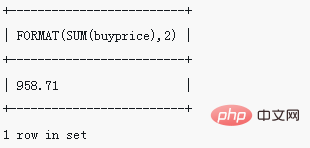How to use sum() function in mysql
In mysql, the sum() function is used to calculate the sum of a set of values or expressions. The syntax is "SUM (DISTINCT expression)". The DISTINCT operator allows calculation of different values in the set. The sum() function needs to be used together with the SELECT statement. If the SUM() function is used in a SELECT statement that does not return matching rows, the SUM() function will return NULL instead of 0; the SUM() function will ignore the columns when calculating. Rows with NULL value.

The operating environment of this tutorial: windows7 system, mysql8 version, Dell G3 computer.
mysql sum() function
The SUM() function is used to calculate the sum of a set of values or expressions. The SUM() function The syntax is as follows:
SUM(DISTINCT expression)
| Description | |
|---|---|
| expression | Required. Field or formula
- If the SUM function is used in a SELECT statement that does not return matching rows, the SUM function returns NULL instead of 0.
- The DISTINCT operator allows calculation of distinct values in a collection.
- The SUM() function ignores rows with NULL column values when calculating.
Usage example of sum() function
In order to facilitate understanding, first create a student score table tb_students_score, students The data content of the score table is as followsmysql> SELECT * FROM tb_students_score;

mysql> SELECT SUM(student_score) AS score_sum FROM tb_students_score;

Extended knowledge:
MySQL SUM and GROUP BY clause
When to use GROUP BY When clauses are combined, the SUM() function calculates the sum for each grouping specified in the GROUP BY clause. For example, you can use the SUM function with a GROUP BY clause to calculate the total amount of each order, as follows:SELECT orderNumber,
FORMAT(SUM(quantityOrdered * priceEach),2) total
FROM orderdetails
GROUP BY orderNumber
ORDER BY SUM(quantityOrdered * priceEach) DESC;+-------------+-----------+ | orderNumber | total | +-------------+-----------+ | 10165 | 67,392.85 | | 10287 | 61,402.00 | | 10310 | 61,234.67 | | 10212 | 59,830.55 | *** 此处省略了一大波数据 ***** | 10116 | 1,627.56 | | 10158 | 1,491.38 | | 10144 | 1,128.20 | | 10408 | 615.45 | +-------------+-----------+ 327 rows in set
MySQL SUM and HAVING
You can use the HAVING clause in the SUM function to filter results based on specific criteria. For example, you can calculate the total order quantity and only select orders with a total amount greater than 60,000. The following query statement-SELECT orderNumber,
FORMAT(SUM(quantityOrdered * priceEach),2)
FROM orderdetails
GROUP BY orderNumber
HAVING SUM(quantityOrdered * priceEach) > 60000
ORDER BY SUM(quantityOrdered * priceEach);
MySQL SUM and LIMIT
Suppose you want to calculate the sum of the top ten most expensive products in the products table, you can ask the following query:SELECT SUM(buyprice) FROM products ORDER BY buyprice DESC LIMIT 10;

SELECT FORMAT(SUM(buyprice),2) FROM (SELECT buyprice FROM products ORDER BY buyprice DESC LIMIT 10) price;

MySQL SUM and NULL
If there are no matching rows, the SUM function returns a NULL value. Sometimes you want the SUM function to return 0 instead of NULL. In this case, you can use the COALESCE function. The COALESCE function accepts two parameters. If the first parameter is NULL, the second parameter is returned, otherwise the first parameter is returned; refer to the following query statement:SELECT COALESCE(SUM(quantityOrdered * priceEach),0) FROM orderdetails WHERE productCode = 'S1_212121';
mysql video tutorial]
The above is the detailed content of How to use sum() function in mysql. For more information, please follow other related articles on the PHP Chinese website!

Hot AI Tools

Undresser.AI Undress
AI-powered app for creating realistic nude photos

AI Clothes Remover
Online AI tool for removing clothes from photos.

Undress AI Tool
Undress images for free

Clothoff.io
AI clothes remover

AI Hentai Generator
Generate AI Hentai for free.

Hot Article

Hot Tools

Notepad++7.3.1
Easy-to-use and free code editor

SublimeText3 Chinese version
Chinese version, very easy to use

Zend Studio 13.0.1
Powerful PHP integrated development environment

Dreamweaver CS6
Visual web development tools

SublimeText3 Mac version
God-level code editing software (SublimeText3)

Hot Topics
 1378
1378
 52
52
 MySQL: Simple Concepts for Easy Learning
Apr 10, 2025 am 09:29 AM
MySQL: Simple Concepts for Easy Learning
Apr 10, 2025 am 09:29 AM
MySQL is an open source relational database management system. 1) Create database and tables: Use the CREATEDATABASE and CREATETABLE commands. 2) Basic operations: INSERT, UPDATE, DELETE and SELECT. 3) Advanced operations: JOIN, subquery and transaction processing. 4) Debugging skills: Check syntax, data type and permissions. 5) Optimization suggestions: Use indexes, avoid SELECT* and use transactions.
 How to open phpmyadmin
Apr 10, 2025 pm 10:51 PM
How to open phpmyadmin
Apr 10, 2025 pm 10:51 PM
You can open phpMyAdmin through the following steps: 1. Log in to the website control panel; 2. Find and click the phpMyAdmin icon; 3. Enter MySQL credentials; 4. Click "Login".
 How to create navicat premium
Apr 09, 2025 am 07:09 AM
How to create navicat premium
Apr 09, 2025 am 07:09 AM
Create a database using Navicat Premium: Connect to the database server and enter the connection parameters. Right-click on the server and select Create Database. Enter the name of the new database and the specified character set and collation. Connect to the new database and create the table in the Object Browser. Right-click on the table and select Insert Data to insert the data.
 MySQL and SQL: Essential Skills for Developers
Apr 10, 2025 am 09:30 AM
MySQL and SQL: Essential Skills for Developers
Apr 10, 2025 am 09:30 AM
MySQL and SQL are essential skills for developers. 1.MySQL is an open source relational database management system, and SQL is the standard language used to manage and operate databases. 2.MySQL supports multiple storage engines through efficient data storage and retrieval functions, and SQL completes complex data operations through simple statements. 3. Examples of usage include basic queries and advanced queries, such as filtering and sorting by condition. 4. Common errors include syntax errors and performance issues, which can be optimized by checking SQL statements and using EXPLAIN commands. 5. Performance optimization techniques include using indexes, avoiding full table scanning, optimizing JOIN operations and improving code readability.
 How to create a new connection to mysql in navicat
Apr 09, 2025 am 07:21 AM
How to create a new connection to mysql in navicat
Apr 09, 2025 am 07:21 AM
You can create a new MySQL connection in Navicat by following the steps: Open the application and select New Connection (Ctrl N). Select "MySQL" as the connection type. Enter the hostname/IP address, port, username, and password. (Optional) Configure advanced options. Save the connection and enter the connection name.
 How to recover data after SQL deletes rows
Apr 09, 2025 pm 12:21 PM
How to recover data after SQL deletes rows
Apr 09, 2025 pm 12:21 PM
Recovering deleted rows directly from the database is usually impossible unless there is a backup or transaction rollback mechanism. Key point: Transaction rollback: Execute ROLLBACK before the transaction is committed to recover data. Backup: Regular backup of the database can be used to quickly restore data. Database snapshot: You can create a read-only copy of the database and restore the data after the data is deleted accidentally. Use DELETE statement with caution: Check the conditions carefully to avoid accidentally deleting data. Use the WHERE clause: explicitly specify the data to be deleted. Use the test environment: Test before performing a DELETE operation.
 How to use single threaded redis
Apr 10, 2025 pm 07:12 PM
How to use single threaded redis
Apr 10, 2025 pm 07:12 PM
Redis uses a single threaded architecture to provide high performance, simplicity, and consistency. It utilizes I/O multiplexing, event loops, non-blocking I/O, and shared memory to improve concurrency, but with limitations of concurrency limitations, single point of failure, and unsuitable for write-intensive workloads.
 MySQL: An Introduction to the World's Most Popular Database
Apr 12, 2025 am 12:18 AM
MySQL: An Introduction to the World's Most Popular Database
Apr 12, 2025 am 12:18 AM
MySQL is an open source relational database management system, mainly used to store and retrieve data quickly and reliably. Its working principle includes client requests, query resolution, execution of queries and return results. Examples of usage include creating tables, inserting and querying data, and advanced features such as JOIN operations. Common errors involve SQL syntax, data types, and permissions, and optimization suggestions include the use of indexes, optimized queries, and partitioning of tables.




%20function%20in%20mysql)
